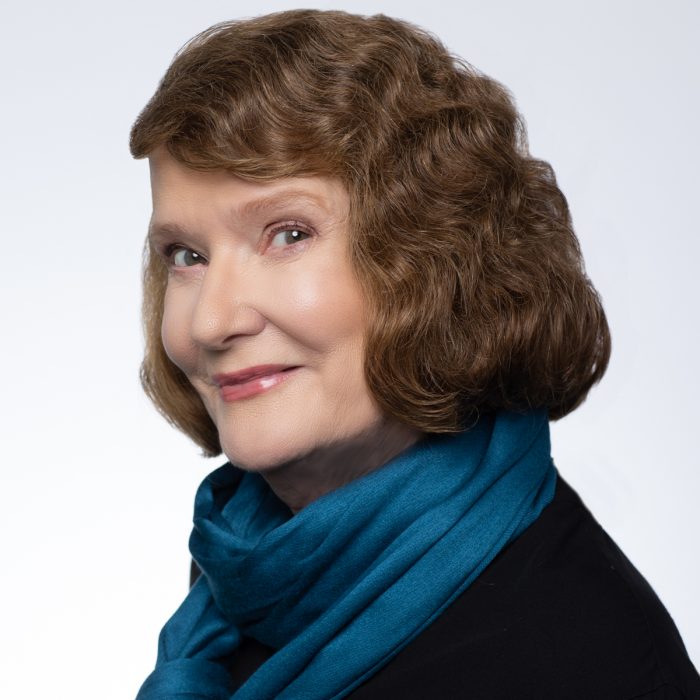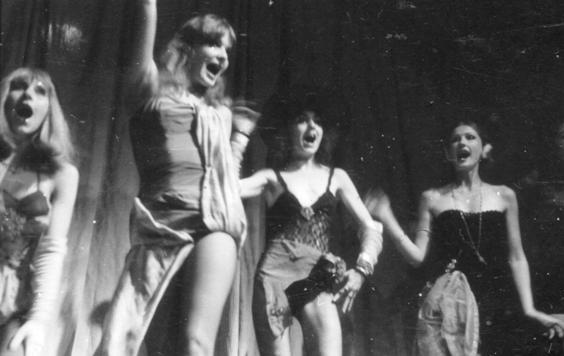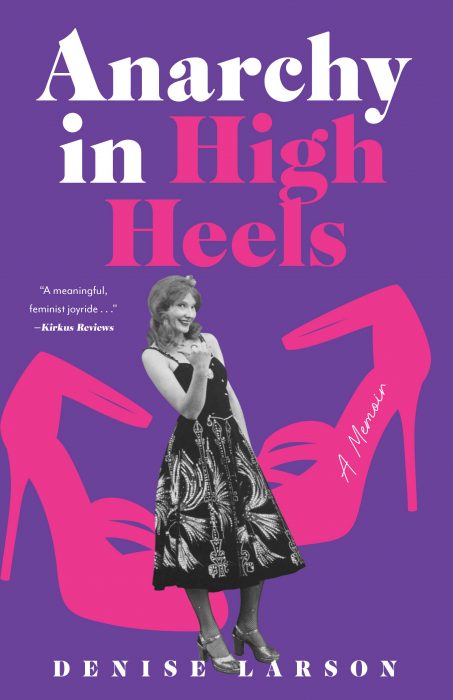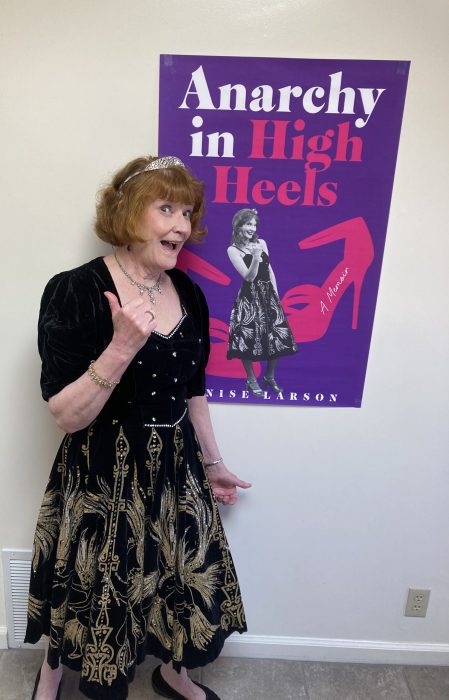Leader of avant-garde, female theater troupe Les Nickelettes back to performing, with Cosmic Elders
If you told 12-year-old Denise Larson that she was going to be the Mama of Les Nickelettes, a feminist experimental theater group with an anything-goes, throw-out-the-rules attitude, she would have stared at you like you had two heads. “I knew I wanted to be a stage actress at 12, but I was painfully shy with no idea how I was going to get there,” Larson said.

But after landing a small part in a play in San Joaquin Delta Junior College and basking in praise from her acting teacher, Larson was on her way.
Larson couldn’t wait to leave the Central Valley town of Manteca where she attended high school. “I only applied to one university – San Francisco State – because San Francisco was where there was theater,” she said. Larson moved to the city in 1967.
Needing a steady income that would leave energy for performing, Larson took a position as a cashier in the Mitchell Brothers O’Farrell Theatre, a strip club and porn theater in the Tenderloin. It was there that Lars0n, and two other women actors, “accidentally” founded Les Nickelettes, when they became faux cheerleaders for the midnight nickelodeon movies and cartoons.
“We bought old thrift store sweaters and sewed on big block letters ‘N’, ‘I,’ and ‘C’, teased our hair into puffy dos, and wore miniskirts. We pranced out singing a cappella, ‘Music! Music! Music,’ camping it up with choreographed 1920-style dance. We turned around, flipped up our skirts, mooned the audience with our underwear, and scampered offstage,” Larson said, “The crowd awarded us with boisterous applause.”

This nascent performance evolved into crafted, feminist satire, original stunts, skits, plays, and adapted material. Les Nickelettes performed mostly in the Bay Area for the next 13 years, until the group disbanded because Larson, its motivating force, wanted to have a baby.
Larson married, had a baby girl, Nikki, and became an early childhood educator, which she did for 20 years until retiring. She then wrote “Anarchy in High Heels,” a memoir of her journey with Les Nickelettes. It told the story of the plays they wrote and produced, the friendships of the women performers, and Larson’s growth as an actor, playwright, producer, stage director, and administrative/artistic director.

What was it like to come from Manteca to San Francisco? Was it as wild as you expected? What were some of your early impressions?
I couldn’t wait to get out of Manteca. Coming to San Francisco was like a dream come true. San Francisco State University was the only university I applied to after community college. Attending university here was the easiest way to learn about the culture and society. And I wanted to be in theater and that meant San Francisco.
I arrived here just after the official Summer of Love in August 1967. I wore a dress with pantyhose and make-up, and there were the hippies in tie-dye, denims, bell bottoms, no make-up, letting their hair flow, smoking pot. Wow! I loved it! It just took me three or four months, and I was a hippie, too!
How did you get interested in theater? What is it you liked and hoped for with a degree in theater? Did you have any role models to look to for inspiration?
I knew I wanted to be an actress when I was 12; it must have been embedded in my subconscious. But, in high school, I kept trying out for parts and I never got one. My drama teacher couldn’t understand why a shy person would want to be in theater; she ignored me.
Before I went to San Francisco State University, I went to San Joaquin Delta Junior College in Stockton and enrolled as a theater major. With the theater training, my desire grew, but it was still painful when I tried out for my first play, “The Good Woman of Szechwan,” by Bertolt Brecht.
The director of the play was also my acting teacher; he knew how shy I was – I never spoke up in class.
I was devastated and depressed when I didn’t get any part. But two or three days later, my professor said a small part had become available and was I interested? I was overjoyed. It was only three lines, but I was on stage a lot, in the background. I was the sister-in-law, moody because I was pregnant, and I loved to gossip.
After the play was over, we were discussing process in class, and the first and second leads were complaining how hard it had been to learn their roles and act. Pointing to me, the professor said, “Here’s a case where that old adage applies, ‘There’s no small roles, only small actors.’ Denise is an example of someone who was in character the whole time and was totally committed.”
That’s when it started for me. Someone like that can change a life, and he changed mine.
I always wanted to be a stage actress. At that time, with the hippie movement, experimental theater, street theater, young people’s theater was the hip thing to do. That’s where I belonged. There were no role models; everyone was starting out the same; no one was ahead of us.
What was experimental in theater like in the 1970s in general, and specifically, Les Nickelettes? How did the group come about? And where did the name come from?
Experimental theater in the 1970s was wild! You could do anything you wanted. We combined dance, theater, comedy, and music in a revolutionary way. We studied Carl Jung’s theory of archetypes that reside in the collective unconscious and persist in a not so obvious way in art, literature, and theater.

We performed “White Blackbird,” based on the Anais Nin diaries. It was a character study of three characters from the diaries. I played June Miller, Henry Miller’s wife, another actress portrayed Antonin Artaud, and one played Anais. We had a woman portray a man, the script was non-linear, and we used modern dance and Indian music to tell parts of the characters’ stories.
During this time, I started gaining confidence as an actress because the performers around me (that) I respected gave me feedback that I was doing good work.
Les Nickelettes came about when I was working as a cashier at The Mitchell Brothers O’Farrell Theater, a strip club near San Francisco’s Tenderloin neighborhood. Vinny, the projectionist, put on midnight shows, featuring Charlie Chaplin movies and Betty Boop cartoons. He called it the People’s Nickelodeon, and admission and food cost a nickel (the nickelodeon was an early movie theater where a film or a variety show could be seen, usually for the admission price of a nickel).
I was telling Vinny about our Anais Nin play. He said to get my women acting friends to be cheerleaders for the Nickelodeon, to be “Nickelettes.” Before this performance, we were disciplined actors, but when three of us women went on stage at the O’Farrell we were drunk and we messed up, but the audience loved it, thought it was fun. So, we asked ourselves, “What are we going to do next week?” It just snowballed from there.
Did you found Les Nickelettes as a feminist theater company? What was feminist about it? Were there other feminist theater companies in San Francisco – or even nationally – at the time, or was your group, or San Francisco groups, the progenitor?
We didn’t form Les Nickelettes as a feminist theater company. It just never occurred to us to have men in the group, it just evolved that way. Women came to us and wanted to be part of what we were doing.
Yes, it was the time of the women’s movement, but at first, we weren’t conscious of our part in it. But after a while, when we got together, we exhibited a sense of humor we hadn’t let out in mixed company before. As women, we had been trained not to tell our own jokes, but to hold back from being ourselves, to be “nice” girls.

My spirit sought to discover a hidden, offbeat, bawdy female humor at a time when being a funny feminist was an oxymoron. Our humor was different from men’s because we were telling our truth about female sexuality.
And we were free to be as bawdy as men, and that’s how we bonded. When we discovered that we could present our humor in public AND get away with it, we were hooked. When we broke free of our conditioning to be nice girls, it was then that we realized we had a platform.
As an example of our kind of humor at a Christmas show at the Mabuhay Gardens, partial lyrics to “The Twelve Days of Christmas”:
One Frederick’s of Hollywood bra,
Two Packard limousines,
Three Woolworth’s diamonds,
Four chastity belts,
Five — replaceable hy-mens!
You wore many hats in the company. What was your favorite and what were the various challenges of those roles?
It turned out my favorite role was that of playwright because you have total control. It’s not like I was a control freak, but words matter, and I wanted to have my creative say. My favorite play was “Peter Pan” because we did it twice, so we developed it more than the others. With our original pieces, afterwards, we always felt that there could be improvement. Also, I liked it the most because of its accessibility – everyone could relate. It had the sharpest satire and humor of all our shows.
We Lampooned Disney’s version of the J.M. Barrie classic by recasting Peter as a pompous rock star who refuses to grow up. With original music.
I loved playing Peter Pan. Poking fun at the bad boys of rock by toting an erect “magic” sword and proclaiming, “No one is going to make me grow up. I’m too smart for that,” was a gas. Peter acted like a cool dude, but when he didn’t get his way, he dissolved into tantrums like a three-year-old, and it was delicious parody
I styled my hair in a unisex mullet and wore a green satin outfit with big-padded shoulders. Inside the crotch of my pants was pinned a thick stuffed sock painted pink at the tip. And the end of my Battle of the Bands song, ‘Don’t Grow up Baby,’ I unzipped my fly and flipped out the sock.
Your other favorites?
Second on the list is stage director because I could guide the actors in developing their roles. I had input into set and costume design, and I could block out the scenes. Acting is my third favorite role. I thought I was a good actor and could get by on singing and dancing.
The biggest challenge was keeping the group going as women came and went from the company. At times it felt like it was falling apart, but I kept it together. It’s hard to explain motivation. I was the mother, the binding force for Les Nickelettes’ 13-year run. It wouldn’t have lasted without me.
From your long perspective on theater, what do you see as different now than when you were involved?
There’s still experimental theater, but I think the big difference now is that it’s more technically advanced. But the basis is still there: take some new and develop a whole story around it.
How did the switch from theater to mother and teacher happen? What drew you to early childhood education? Did you have to get another degree or credentials?

I wanted to have a child very badly and I met a man who also wanted a child. So, it was time for me to do that.
Early childhood education was a natural choice: kids love to play and have fun. I got 12 units of early childhood education at San Francisco State. It was great to use my theater skills with the kids.
I taught for nine years at the One Fifty Parker Avenue School, then at the City of Pacifica Child Care Services for four years until they ran into budget problems. Then I worked with San Francisco Head Start as a teacher for two years, and then as center director of the Potrero Hill Head Start Center for six years until I retired.
Did you do any theater work during your teaching career? Tell us what you’re doing now with Cosmic Elders?
No more theater work after I married, had a child, and was working full-time – that was enough.
When I was finishing the final revisions on “Anarchy in High Heels,” I needed something else to start my engine. Parks and Rec was offering a class, “Improv and Games for Seniors.” Older people having fun – what could be better?
Eventually, the group split into two, those who didn’t want to perform and those who did. Us performers became the Cosmic Elders and even performed on Zoom during the pandemic. I love being back performing again.






Paulann Sternberg
P.S. from Paulann to columnist Jan Robbins: Great interview (of Denise Larson, author of Anarchy in High Heels)/! Thanks so much for that much deserved spotlight on Denise.
Paulann Sternberg
"It turned out my favorite role was that of playwright because you have total control. It’s not like I was a control freak, but words matter, and I wanted to have my creative say." Denise, those are words worth quoting and remembering. You continue to inspire the writer, performer and plain ol'' ordinary (aging) woman in me. Long may you wave! :-)